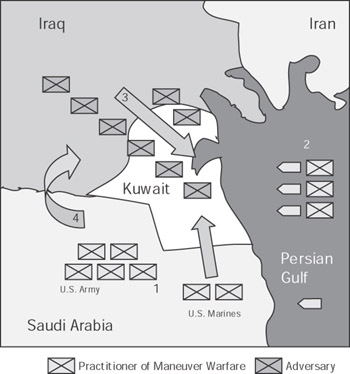Coalition Attack in Operation Desert Storm: Ambiguity
In Operation Desert Storm, the direction of the Coalition Forces attack was so ambiguous to the Iraqis that they did not know what to expect, and their defense became too widely dispersed to be effective.
The Coalition s activity prior to the attack forced Iraqi president Saddam Hussein and his generals to allocate their combat resources to three fronts, all of which were possible avenues of attack. Although Iraq maintained the fourth-largest land army in the world at the time, preparing for every eventuality inevitably created a weakness, the lightly defended western end of the Iraqi line, which the Coalition ultimately exploited.
Initially the Coalition Forces, consisting of an alliance of thirty-five countries and commanded by U.S. general Norman Schwarzkopf, deployed on the ground in two general formations to the southwest of Iraq. First, a force of about fifty thousand ground troops, massed due south of Kuwait City in the Saudi desert, posed the most immediate threat: an attack right up the middle could immediately break Saddam s grip on the oil-rich lands of Kuwait. A second ground force, consisting of highly mobile armor , air assault, and mechanized infantry units and five times larger than the first, assembled in the Saudi desert and threatened Iraq s western flank.
Already presenting two credible attacks, the Coalition then began to assemble a third ”the largest amphibious force since the 1950 invasion of Inchon ”in the Persian Gulf. [13] U.S. Navy battleships bombarded coastal targets with massive projectiles , up to two thousand pounds , and U.S. Navy cruisers, destroyers, and submarines launched devastatingly accurate Tomahawk missiles. Additionally, eighteen thousand troops were positioned to hit the beach aboard amphibious personnel carriers and high-speed hovercraft under the cover of carrier-based jets and helicopters.
Eventually Saddam showed his hand and moved about eighty thousand of his troops ”mostly units from the vaunted Republican Guard ”from strategic reserve to the south to defend against the possible amphibious assault. This commitment weakened Iraq s available defenses elsewhere and placed Schwarzkopf in a position to dictate the terms of the contest.

Figure 6.2: Coalition Attack, Operation Desert Storm, 1991
-
Army and Marine units build up to the south.
-
Navy ships move north into the Persian Gulf.
-
Iraqis respond by moving ground units south to defend against everything.
-
The smaller Marine force drives up the middle, while the main blow comes from the U.S. Army s left hook into the weakened Iraqi western flank.
The Coalition immediately responded with a ground-based attack from the west. Schwarzkopf s plan called for a quick strike up the middle from the Marine-led force in the south and a fast-moving, powerful left hook from the XVIII Corps into Saddam s depleted western flank. This one-two punch crushed the once-formidable Iraqi Army and ended the war exactly a hundred hours after the launch of the ground attack.
Leadership Lessons
Because the defender is assumed to have built entrenched, fortified positions and have had time to lay away munitions and other supplies , defense is generally considered the stronger form of combat. But this maxim rests on the assumption that the defender knows when the attack will occur and from which direction it will come. By creating multiple credible threats and obscuring its intentions, the Coalition was able to seize the advantage from the confused and overextended Iraqi defenders and pick the most vulnerable point to attack. Generally speaking, an attacker can use ambiguity to maintain maximum flexibility and avoid committing resources until the defender exposes a significant weakness in his own preparation and deployment of resources, thereby rendering the offense the stronger form of combat.
[13] U.S. Navy War College, The United States Navy in Desert Shield / Desert Storm, May 1991.
EAN: 2147483647
Pages: 145